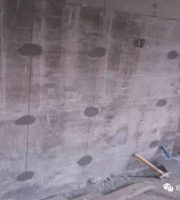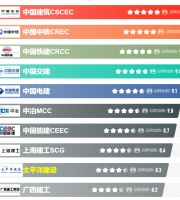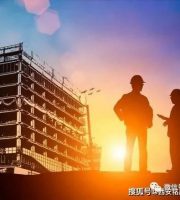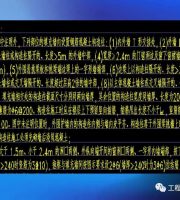The flaw detection length shall not be less than 200mm and not less than 1 weld.
Ordinary bolts shall comply with the national standard hexagon head bolts – grade A and B (gb5782), the anchor bolt shall be made of Q235B steel.
6) Welding shall be started after the completion of assembly spot welding, and full penetration welding shall be adopted; During welding, the upper and lower wing plates shall be subject to backing welding first, and then the cover surface shall be welded as required to prevent welding deformation.
The lifting point is generally at the position with the minimum peak moment of the truss, generally at 1 / 4 of the two ends.
When the weld length is less than 200mm, the whole weld shall be flaw detected; For field installation welds, the percentage shall be calculated according to the number of welds of the same type and welding conditions.
Project overview 1.1 introduction to steel truss materials the round steel pipe adopts straight seam steel pipe, and the material of stiffener is the same as that of base metal.
2.3 hoisting process flow and method: the roof truss shall be hoisted from bottom to top.
Roof area B: steel columns are steel pipe lattice columns (inclined columns) , the column base is connected with the pin shaft, and the column top is connected with the pin shaft of the lower chord of the ring truss; a total of 4 main trusses are set, the main truss (plane truss) is about 30m long, and the ring truss (inverted triangle truss) is set in three external directions Wind resistant column: triangular lattice column, 9 pieces in total.
Single truss is used for overall hoisting.
7) Splicing and butt welds are class II welds, and all butt full penetration welds shall be subject to ultrasonic flaw detection as required; For unqualified welds, the defective parts can be reworked and re welded by carbon arc gouging or cutting, but the same part should not be reworked more than twice to avoid variation of steel performance and solid temperature; The quality grade and defect classification of grade II welds shall comply with the provisions in the following table: the weld quality grade is grade I and grade II.
After the truss is corrected and qualified, the bolts of each part can be finally tightened for final fixation; By analogy, gradually hoist the truss of the next axis..
3) During assembly, the sectional members shall be assembled in place on the platform according to the design requirements according to the drawing number sequence.
See the following table: the minimum thickness of the weldment TT ≤ 78 ≤ t ≤ 1011 ≤ t ≤ 1314 ≤ t ≤ 16 fillet weld The joint height is hf671012.
When the roof truss is connected with the support, the verticality and installation of the truss shall be corrected and finally fixed.
8) Precautions for assembly: check the components before ground assembly.
The pre camber value shall be carried out in accordance with the drawings and specifications.
The radiographic flaw detection evaluation grade of internal defects is grade II and III.
When manual welding is adopted, Q235 E43 type welding rod is used for B steel and E50 type welding rod is used for Q345B steel.
Roof area a: the steel column is steel pipe lattice column (inclined column) , the column base is connected with the pin shaft, and the column top is connected with the pin shaft of the lower chord of the ring truss; a total of 4 main trusses are set, the main truss (plane truss) is about 38.5m long, and the ring truss (inverted triangular truss) wind resistant columns are set in three external directions: triangular lattice columns, a total of 12 pieces.
1.2 overview of steel truss: South (zone a) and North (zone B) : its form is: main and secondary two-way plane trusses, circular space three-dimensional trusses, facade space wind resistant trusses, and the structural system composed of horizontal supports and tie bars.
During automatic or semi-automatic welding, the flux and welding wire used shall adapt to the strength of the main metal material, and the tensile strength of the deposited metal shall not be lower than that of the corresponding welding rod.
The welded load-bearing structure and important non load-bearing structure shall have the qualification guarantee of cold bending test.
The steel shall have good weldability and qualified impact toughness.
Note: the counting method of flaw detection proportion shall be determined according to the following principles: weld the factory The percentage of welds shall be calculated according to each weld, and the flaw detection length shall not be less than 200mm.
The hoisting of all superstructure shall be carried out only after the substructure is in place, corrected and the supporting members are fastened.
When the truss span is greater than 24m, it can be L / 500, and the small span does not need to be cambered.
The friction surface must be flat and dry, and it is not allowed to work in the rain; After the ground assembly is completed, the components are padded with oil-free sleepers, and both sides of the components are supported with wooden bars to enhance stability; Check the lifting point, alignment datum point and centerline.
After the installation and welding of all members, unload the lifting points and slowly remove the hook.
The flaw detection proportion of grade AB is 100% 20%.
1 On site assembly of roof truss: 1) before assembly, an operation platform shall be made on the construction site, and camber shall be set on the platform to ensure that the assembly quality of steel truss meets the design requirements.
The main truss and embedded parts are made of Q345B, the support and tie rod are made of Q235B, and individual materials are q355b, etc.
2) the components of each steel truss shall be assembled on the assembly platform according to the drawing requirements.
The fillet weld height shall be selected according to the minimum thickness of the weldment.
5) The pre camber value of the truss shall also be considered during the assembly of the pipe truss.
After slowly hoisting, pay attention to the installation direction to prevent collision with the substructure, and then slowly fall into place.
Key technology 2.1 roof truss assembly roof truss shall be cut in the factory, prefabricated in sections, shot blasted and derusted at Sa2.5 level, painted with primer into semi-finished products and transported to the installation site for assembly; after the components are transported to the site, they shall be classified, counted, reviewed for size and identification according to the drawings, and checked for quality certificates, design change documents and technical documents necessary for component delivery Technical data.
Specifically: ① before hoisting, the elevation shall be measured to the substructure by using the hanging steel ruler and level gauge method, so as to control the elevation of each point where the truss intersects with the substructure.
Then install the supporting truss members between the connecting truss beams.
② After the intersection node between the truss beam chord and the substructure reaches the design elevation, the truss beam chord and the substructure shall be spot welded first.
The steel shall have obvious yield step, and the elongation shall be greater than 20%.
After the roof truss is assembled on the ground, the assembled steel truss shall be transported to the installation position.
The truss connection node adopts pin node, ball node, plate node, etc., and the corresponding parts are constructed according to the drawing.
(1) Hoisting and installation process of roof truss: ground positioning → inspection → aerial hoisting → support connection (steel column installation) → inspection → hoisting of support, pull rod and main truss → hoisting of short secondary truss → welding of horizontal tie rod → correction and inspection → support fixation.
(when the steel pipe is butted, the lining pipe is added, V-groove welding is adopted, and the butt gap is 5mm) 4) when the pipe truss is assembled, the upper chord is spliced first, the lower chord is spliced, then the web member between the upper and lower chords is spliced, then the upper chord and the member between the upper chord are spliced, and finally the web member between the upper and lower chords is assembled to complete the assembly.
Before hoisting, it shall be controlled by sliding rope at both ends.
1.
The ultrasonic flaw detection evaluation grade of internal defects is grade II and III.
The anti sliding coefficient of steel friction surface connected by high-strength bolts is 0.5, and the grade of high-strength bolts is 10.9.
The flaw detection proportion of grade B is 100% 20%.
2.2 roof truss hoisting 1) hardening of hoisting site, selection of hoisting equipment and hoisting points: generally, the temporary support shall be installed first, and the hoisting of primary and secondary trusses shall be carried out after installation in place.
Generally, there are no less than 4 lifting points.
2.
In general, multiple truck cranes are used for steel truss hoisting, and the assembled pipe truss unit and hoisting rod are hoisted respectively to connect the pipe truss unit.
Other Roofs: adopt the forms of spatial honeycomb space truss, open web space truss, sheet truss and H-shaped roof steel beam.
In order to ensure the normal progress of hoisting construction, the traveling route site of truck crane shall be leveled and hardened.
The ratio of the measured value of tensile strength to the measured value of yield strength of steel shall not be less than 1.2.
After the elevation of both ends and the perpendicularity of the whole truss are determined, it shall be welded and fixed.
Wherein (the weld leg size at the connection between web member and chord is 6mm, the weld grade is grade II, and the connection between primary and secondary truss and ring truss is intersecting weld).
If the deformation and defects of the components exceed the allowable deviation, they must be handled; Check the friction surface of high-strength bolt connection, and there shall be no mud, sand and other sundries.




